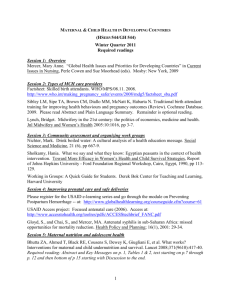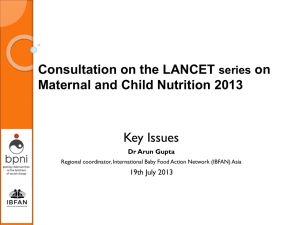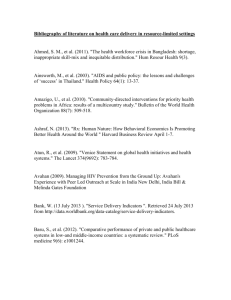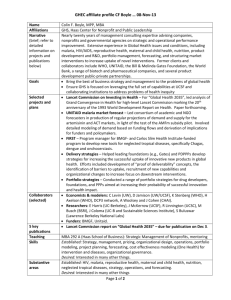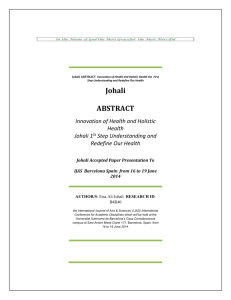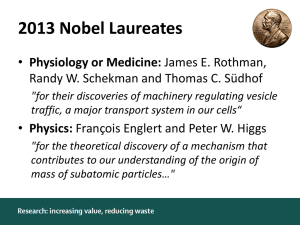Issue 1 June 2002
advertisement
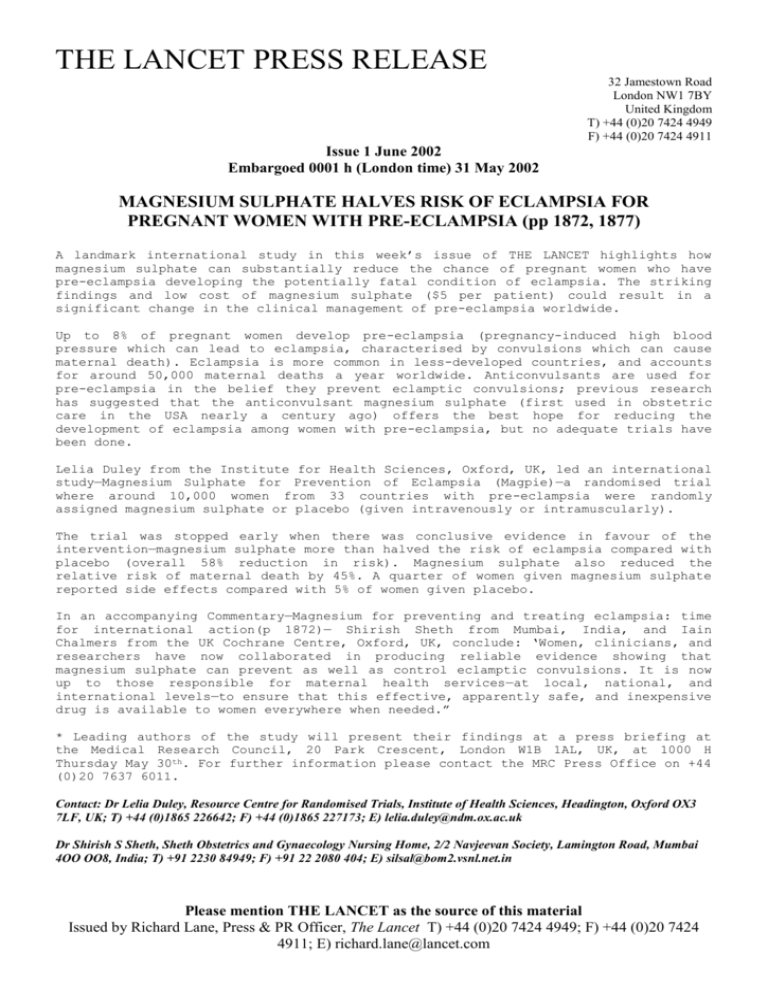
THE LANCET PRESS RELEASE 32 Jamestown Road London NW1 7BY United Kingdom T) +44 (0)20 7424 4949 F) +44 (0)20 7424 4911 Issue 1 June 2002 Embargoed 0001 h (London time) 31 May 2002 MAGNESIUM SULPHATE HALVES RISK OF ECLAMPSIA FOR PREGNANT WOMEN WITH PRE-ECLAMPSIA (pp 1872, 1877) A landmark international study in this week’s issue of THE LANCET highlights how magnesium sulphate can substantially reduce the chance of pregnant women who have pre-eclampsia developing the potentially fatal condition of eclampsia. The striking findings and low cost of magnesium sulphate ($5 per patient) could result in a significant change in the clinical management of pre-eclampsia worldwide. Up to 8% of pregnant women develop pre-eclampsia (pregnancy-induced high blood pressure which can lead to eclampsia, characterised by convulsions which can cause maternal death). Eclampsia is more common in less-developed countries, and accounts for around 50,000 maternal deaths a year worldwide. Anticonvulsants are used for pre-eclampsia in the belief they prevent eclamptic convulsions; previous research has suggested that the anticonvulsant magnesium sulphate (first used in obstetric care in the USA nearly a century ago) offers the best hope for reducing the development of eclampsia among women with pre-eclampsia, but no adequate trials have been done. Lelia Duley from the Institute for Health Sciences, Oxford, UK, led an international study—Magnesium Sulphate for Prevention of Eclampsia (Magpie)—a randomised trial where around 10,000 women from 33 countries with pre-eclampsia were randomly assigned magnesium sulphate or placebo (given intravenously or intramuscularly). The trial was stopped early when there was conclusive evidence in favour of the intervention—magnesium sulphate more than halved the risk of eclampsia compared with placebo (overall 58% reduction in risk). Magnesium sulphate also reduced the relative risk of maternal death by 45%. A quarter of women given magnesium sulphate reported side effects compared with 5% of women given placebo. In an accompanying Commentary—Magnesium for preventing and treating eclampsia: time for international action(p 1872)— Shirish Sheth from Mumbai, India, and Iain Chalmers from the UK Cochrane Centre, Oxford, UK, conclude: ‘Women, clinicians, and researchers have now collaborated in producing reliable evidence showing that magnesium sulphate can prevent as well as control eclamptic convulsions. It is now up to those responsible for maternal health services—at local, national, and international levels—to ensure that this effective, apparently safe, and inexpensive drug is available to women everywhere when needed.” * Leading authors of the study will present their findings at a press briefing at the Medical Research Council, 20 Park Crescent, London W1B 1AL, UK, at 1000 H Thursday May 30th. For further information please contact the MRC Press Office on +44 (0)20 7637 6011. Contact: Dr Lelia Duley, Resource Centre for Randomised Trials, Institute of Health Sciences, Headington, Oxford OX3 7LF, UK; T) +44 (0)1865 226642; F) +44 (0)1865 227173; E) lelia.duley@ndm.ox.ac.uk Dr Shirish S Sheth, Sheth Obstetrics and Gynaecology Nursing Home, 2/2 Navjeevan Society, Lamington Road, Mumbai 4OO OO8, India; T) +91 2230 84949; F) +91 22 2080 404; E) silsal@bom2.vsnl.net.in Please mention THE LANCET as the source of this material Issued by Richard Lane, Press & PR Officer, The Lancet T) +44 (0)20 7424 4949; F) +44 (0)20 7424 4911; E) richard.lane@lancet.com THE LANCET PRESS RELEASE 32 Jamestown Road London NW1 7BY United Kingdom T) +44 (0)20 7424 4949 F) +44 (0)20 7424 4911 Sir Iain Chalmers, UK Cochrane Centre, NHS R&D Programme, Summertown Pavilion, Middle Way, Oxford, OX2 7LG, UK; T) +44 (0)1865 516300; F) +44 (0)1865 516311; E) ichalmers@cochrane.co.uk Please mention THE LANCET as the source of this material Issued by Richard Lane, Press & PR Officer, The Lancet T) +44 (0)20 7424 4949; F) +44 (0)20 7424 4911; E) richard.lane@lancet.com THE LANCET PRESS RELEASE 32 Jamestown Road London NW1 7BY United Kingdom T) +44 (0)20 7424 4949 F) +44 (0)20 7424 4911 Issue 1 June 2002 Embargoed 0001 h (London time) 31 May 2002 DRUG PRESCRIBING BY NURSES IN THE UK – EDITOR OF THE LANCET URGES CAUTION (p 1875) The contentious issue of drug prescribing by nurses is assessed by Richard Horton, Editor of THE LANCET, in a Commentary in this week’s issue of the journal. He concludes that UK government plans to introduce unrestricted prescribing rights to nurses over the next few years could have serious consequences in the provision of health care. Richard Horton comments: “Nurse prescribing offers enormous benefits to patients. But the evidence indicates that the rate at which nurse prescribing is being implemented holds grave dangers if the policy set out by Milburn [Minister for Health], Jones [Royal College of Nursing], and others is acted upon – and the first supplementary nurse prescribers are supposed to be qualified by the end of this year – the UK will be embarking on a dangerous uncontrolled experiment.” The Commentary is critical of the motives which underlie current UK government thinking on drug prescribing. Horton adds: “Nurses are being manipulated, under the guise of providing quicker and more efficient access to health care to fill the gaps left by too few doctors. Prescribing is not a major advance in professional status for nurses. It is merely redrawing the boundaries of a profession to serve an acute political problem, with little regard for the impact it will have either on nursing or patient care. Moreover, when doctors prescribe, they make mistakes. Only very recently have we begun to understand why [see Lancet 2002; 359: 1373-78]. Surely we must learn more about why errors take place before further widening prescribing responsibilities. To extend the burden of risk so quickly is reckless.” The additional training of nurses required for drug prescribing is highlighted as a crucial issue, yet there exist major inconsistencies within current nursing curricula, Horton observes: “If prescribing rights are extended to all drugs, nurses will need to know basic and clinical pharmacology – including the mechanism of action of drugs, pharmacokinetics, pharmacodynamics, and how to appraise evidence from clinical trials. In other words, we will be training nurses to be more like doctors. Is that really the future of nursing. This issue is not a question of retraining interprofessional barriers. It is about respecting distinctive professional expertise at a time when there is a serious nursing shortage.” Please mention THE LANCET as the source of this material Issued by Richard Lane, Press & PR Officer, The Lancet T) +44 (0)20 7424 4949; F) +44 (0)20 7424 4911; E) richard.lane@lancet.com THE LANCET PRESS RELEASE 32 Jamestown Road London NW1 7BY United Kingdom T) +44 (0)20 7424 4949 F) +44 (0)20 7424 4911 Richard Horton concludes: “Taken together, this evidence, and the uncertainties and arguments that flow from it, send a clear message to government: slow down the process of widening prescribing rights. Nurse prescribing has too much to offer patient care to let it founder through hasty and politically expedient implementation.” Contact: Dr Richard Horton, c/o Richard Lane, The Lancet Press Office, 32 Jamestown Road, London NW1 7BY, UK; T) +44 (0)20 7424 4949; F) +44 (0)20 7424 4912; E) richard.lane@lancet.com Please mention THE LANCET as the source of this material Issued by Richard Lane, Press & PR Officer, The Lancet T) +44 (0)20 7424 4949; F) +44 (0)20 7424 4911; E) richard.lane@lancet.com THE LANCET PRESS RELEASE 32 Jamestown Road London NW1 7BY United Kingdom T) +44 (0)20 7424 4949 F) +44 (0)20 7424 4911 Issue 1 June 2002 Embargoed 0001 h (London time) 31 May 2002 NEW DIAGNOSTIC FAECAL TEST COULD IDENTIFY COLORECTAL CANCER (p 1917) Authors of a research letter in this week’s issue of THE LANCET describe a new technique where the detection of a specific protein in faeces could be a marker for colorectal cancer. Colorectal cancer is a common disease (causing around 500,000 deaths each year worldwide), and screening methods that are more reliable than colonoscopy and faecal-blood assessment are needed for earlier disease detection. Nicholas Coleman and colleagues from the MRC Cancer Cell Unit, Cambridge, UK, aim to develop a non-invasive, stool-based assessment that can identify a specific protein — minichromosome maintenance protein 2 (MCM2) — which is present in cancerous colorectal cells but not normal cells. In a clinical study, the investigators detected MCM2-positive cells from 37 of 40 patients known to have colorectal cancer; there was no detection of the protein in any of the 25 healthy individuals (the control group). Nicholas Coleman comments: “These findings suggest that detection of MCM2 in colonocytes retrieved from the faecal surface might be of value in the non-invasive diagnosis of malignant colorectal disease. The conditions of this study do not represent those of a general screening setting, and our findings might have differed in a population with a higher frequency of cancers of the right-side of the colon. Nevertheless, despite the requirement for rapid stool processing, our approach might ultimately prove suitable for population screening, either alone or in combination with other tests.” Contact: Dr Nicholas Coleman, MRC Cancer Cell Unit, Hutchison/MRC Research Centre, Cambridge CB2 2XZ, UK; T) +44 (0)1223 763285; M) +44 (0)7900 596465; F) +44 (0)1223 763284; E) nc109@cam.ac.uk Please mention THE LANCET as the source of this material Issued by Richard Lane, Press & PR Officer, The Lancet T) +44 (0)20 7424 4949; F) +44 (0)20 7424 4911; E) richard.lane@lancet.com THE LANCET PRESS RELEASE 32 Jamestown Road London NW1 7BY United Kingdom T) +44 (0)20 7424 4949 F) +44 (0)20 7424 4911 Issue 1 June 2002 Embargoed 0001 h (London time) 31 May 2002 OLDER AGE OF MALE PARTNERS MAKES YOUNG WOMEN MORE SUSCEPTIBLE TO HIV-1 INFECTION (p 1896) Results of a field study in Zimbabwe published in this week's issue of THE LANCET highlight how cultural aspects of sexual behaviour are closely associated with an increased rate of HIV-1 infection among young women compared with young men. HIV-1 prevalence typically rises more rapidly at young ages in women than in men in sub-Saharan Africa. The reasons for this are thought to include the greater susceptibility of women to HIV-1 infection, and their greater exposure to infection through sexual contact with older partners. Simon Gregson from Imperial College, London, UK, and colleagues from Zimbabwe and UNAIDS, Geneva, Switzerland, investigated the possible association between age of sexual partners among young men and women (aged younger than 25 years) in relation to HIV-1 prevalence. Using data from a field study in rural Manicaland, a province in eastern Zimbabwe, the investigators assessed the onset and degree of sexual activity, numbers of partners, concurrent partnerships, condom use, and partner characteristics from around 10,000 men and women selected from over 8200 households. Young women formed partnerships with men 5-10 years older than themselves, whereas young men were found to have relationships with women of a similar age or slightly younger. Young men reported more partners, more infrequent sexual intercourse, and greater condom use than young women. Simon Gregson comments: "It has long been suspected that younger women having relationships with older men contributes to the spread of HIV infection in young women in sub-Saharan Africa. However, we describe and provide empirical evidence that shows this effect in a rural population in Zimbabwe. This aspect of sexual partner networks plays a pivotal role in the persistence of major HIV epidemics because not only do large segments of successive cohorts of young women become infected through this route, but many further infections result when these women marry and have children. Breaking this link in the pattern of transmission must become a central focus of HIV prevention strategies." Please mention THE LANCET as the source of this material Issued by Richard Lane, Press & PR Officer, The Lancet T) +44 (0)20 7424 4949; F) +44 (0)20 7424 4911; E) richard.lane@lancet.com THE LANCET PRESS RELEASE 32 Jamestown Road London NW1 7BY United Kingdom T) +44 (0)20 7424 4949 F) +44 (0)20 7424 4911 Contact: Dr Simon Gregson, Department of Infectious Disease Epidemiology, Imperial College Faculty of Medicine, University of London, Norfolk Place, London W2 1PG, UK; T) +44 (0)20 7594 3279; F) +44 (0)20 7594 3927; E) s.gregson@ic.ac.uk Please mention THE LANCET as the source of this material Issued by Richard Lane, Press & PR Officer, The Lancet T) +44 (0)20 7424 4949; F) +44 (0)20 7424 4911; E) richard.lane@lancet.com THE LANCET PRESS RELEASE 32 Jamestown Road London NW1 7BY United Kingdom T) +44 (0)20 7424 4949 F) +44 (0)20 7424 4911 Issue June 2002 FOR IMMEDIATE RELEASE THE LANCET INFECTIOUS DISEASES (TLID) This month’s issue gives extensive coverage to tuberculosis ahead of the World TB Congress taking place in Washington D.C. from June 3-5. News desk - Findings from the WHO's 6th annual report on global TB controlThis report states that around 70% of TB cases still remain undetected and that expanding directly-observed treatments (DOTs) in endemic countries, together with a huge cash injection are needed if the targets for global TB control are going to be reached. News feature - "Russia learns to cope with tuberculosis" looks at the problems and challenges the country faces in a time when a coherent TB policy is urgently needed to stop the disease sweeping through the population at the current rate. Personal view - Problems and solutions for the STOP TB partnership. Sally Blower (University of California Los Angeles School of Medicine) and Chuck Daly (University of California San Francisco) discuss why the goals of the STOP TB movement for 2005 will not be achieved by the current control efforts; they recommend strategies on how the targets will be reached. Leading edge - Sex matters for tuberculosis control. A much under-reported issue on the impact of sex on this disease. Almost 1 billion women and girls are infected with tuberculosis worldwide, a 70% excess of male over female TB cases are reported globally each year and the case fatality rate is much higher in women than men. The editorial discusses the possible reasons for this disparity and explores the social, economic, and physical impact the disease has on women in the developing world. The editorial reminds us that we must not neglect basic research into the prevalence and epidemiology of TB if we are to stand a chance against this debilitating disease. Rabies re-examined With around 50 000 people dieing from rabies every year, this disease is a major public-health problem. Charles E Rupprect from the Centers for Disease Control and Prevention, Atlanta, USA, and colleagues describe the epidemiology and diagnosis of this viral zoonosis. Current medical emphasis relies heavily on prevention of exposure and intervention before clinical onset. The authors discuss the current preventative measures and the ways of controlling if not eliminating this disease, in the absence of a cure. A companion review of the neurological aspects of rabies appears in the June issue of The Lancet Neurology. Other reviews: Update on Kaposi’s sarcoma Please mention THE LANCET as the source of this material Issued by Richard Lane, Press & PR Officer, The Lancet T) +44 (0)20 7424 4949; F) +44 (0)20 7424 4911; E) richard.lane@lancet.com THE LANCET PRESS RELEASE 32 Jamestown Road London NW1 7BY United Kingdom T) +44 (0)20 7424 4949 F) +44 (0)20 7424 4911 Therapeutic vaccination against chronic viral infections Hospital-acquired legionellosis: solutions for a preventable infection THE LANCET ONCOLOGY (TLO) CANCER MORTALITY IN CENTRAL–EASTERN EUROPE: FACTS BEHIND THE FIGURES This review highlights how death from cancer in central-eastern Europe is still rising, despite the fact that cancer deaths for the whole of Europe have been falling over the past decade. Differences in lifestyle and environmental exposure are the most likely causes of cancer death in centraleastern European countries, which are linked to political, social, and economic inequalities. Lajos Döbrossy, former Regional Advisor for cancer control in European region of WHO and author of the review, concludes that even if attempts at cancer prevention are eventually realised, a major cancer burden will persist in this part of Europe for many decades to come. Phyto-oestrogens and cancer In this review, Herman Adlercreutz from the University of Helsinki, Finland, discusses the consumption of phyto-oestrogen-rich foods such as soy, a source of isoflavones, and whole grain products, which contain lignans, and their role in the prevention of breast, prostate, and colon cancer. In women, a soy-containing diet is more likely to protect against breast cancer if regularly consumed before puberty or during adolescence. Hormonal resynchronisation—an occupational hazard This month’s Leading Edge editorial discusses the effect of jetlag on cancer risk in light of new data recently presented at the American Association of Cancer Research. It highlights how destabilised concentrations of the hormone melatonin (which regulates the ‘body clock’) could increase breast-cancer risk in female flight attendants. The editorial concludes by emphasising the need for the consideration of the impact of unsocial shift patterns on longterm health outcomes. Other Reviews: Population screening for cancer-related germline gene mutations Reactivation of replication of hepatitis immunosuppressive therapy: an unresolved issue B and C viruses after Please mention THE LANCET as the source of this material Issued by Richard Lane, Press & PR Officer, The Lancet T) +44 (0)20 7424 4949; F) +44 (0)20 7424 4911; E) richard.lane@lancet.com THE LANCET PRESS RELEASE 32 Jamestown Road London NW1 7BY United Kingdom T) +44 (0)20 7424 4949 F) +44 (0)20 7424 4911 Impact of the Human Genome Project on the clinical management of sporadic cancers An oncological view on the blood–testis barrier Please mention THE LANCET as the source of this material Issued by Richard Lane, Press & PR Officer, The Lancet T) +44 (0)20 7424 4949; F) +44 (0)20 7424 4911; E) richard.lane@lancet.com


